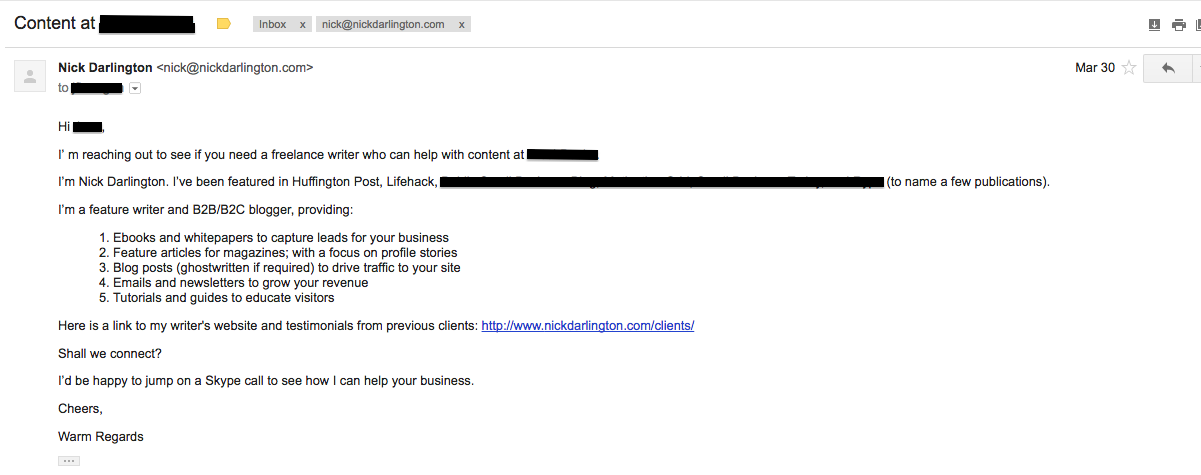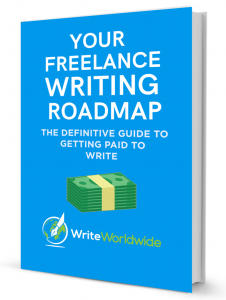Are you sending cold pitch after cold pitch with very few responses and no clients to show for your efforts?
There may be several reasons why you’re not getting results. It may be that:
- You’re targeting people who aren’t currently in the market for freelance writers. And that’s okay; you’ll just have to keep pitching until you find those that are
- You’re focused on the wrong types of clients: they don’t have the budget or don’t see the value in content marketing. Again, keep going until you find someone who does
- Your prospect is busy and hasn’t had time to respond. This is often the case, and that’s why it’s so important that you follow up
But usually, the main reason you don’t see results is because your pitch is poor. This begs the question: How do you know whether your pitch is good or bad?
In this post, I’m going to share the cold email that landed me $10,400 (and counting). I’m then going to dissect it and share six key lessons. These lessons will, in effect, become steps that you can follow to craft your own irresistible cold pitch.
And, if you don’t want to spend the time doing that you can simply “steal” my pitch that I’ll provide you in the form of a template (thanks must go to Bamidele Onibalusi of Writers in Charge for this template, which I’ve altered for my use). Yes, I’m giving you permission to steal it!
But before I move on I want to mention two things:
Firstly, a pitch does not occur in isolation; you need a solid foundation. The foundation refers to a writer’s website that shows you’re a professional and social proof that tells your client you can get the job done.
If you need help with these two aspects here are two posts to get you started:
- How to Build Your Foundation as a Freelance Writer
- How to Start a Freelance Writing Career With No Writing Samples
Secondly, a successful pitch requires that you spend time prospecting for clients. To help you with this read Richard’s post about the process he uses to prospect for and find clients on LinkedIn.
With that out the way, let’s jump in.
The Cold Pitch That Got The Gig
Here’s the pitch I sent to the client I was telling you about earlier:

With that pitch, I got a response, and after a few email exchanges, we agreed on $250 per blog post. She later increased my rate to $300 because I was delivering quality.
I have since skyrocketed my income with that client by going above and beyond what’s expected, to the point where I comfortably make $1500-$2000 per month with that client.
If you want to learn more about how I did this read the article Make Money Freelance Writing: How I Skyrocketed My Freelance Writing Income.
By analysing the pitch, there are several lessons you can learn and apply to crafting your own successful cold pitches.
Lesson 1: Subject Lines Matter
You need a subject line that will encourage people to open your email. Without it, your pitch won’t even matter and will simply be discarded to the trash folder. But what exactly makes a good headline?
If you have a look at the headline I used – “Content at [insert company]” – you’ll see that it’s concise and evokes curiosity.
It’s also targeted at my target market. Most of the prospects I reach out to are content managers and content directors. So, when they read the email they will have a vague idea what it’s about, but be curious enough to open it.
Lesson 2: Personalise, Personalise, Personalise!
The people you’re targeting get lots of emails daily, and many people are vying for their time.
If you include only a “Hi,” “Hello,” or “Good Day”, without addressing the person by name, they’ll bin that email; I guarantee you. The same can be said about calling someone sir when they’re female and vice versa. What does it say about you if you haven’t taken the time to research the person you’re pitching too? If you don’t care, why should they?
Personalization shouldn’t stop there – make sure you have their email address (not some generic info@companyname.com) and that you mention their company name, whether in the subject line or the body of text.
Again this shows the editor that you’ve taken the time to find their contact info and research the company.
See how I’ve done all the above in my pitch? I mentioned the company’s name in the subject line, in the body, and I’ve taken the time to find the name of the person and their email address.
If you’re having trouble finding the name of the editor, use Google or LinkedIn. For example, most companies will have LinkedIn profiles, go into the LinkedIn profile, view the employees that work there and scroll down that list.
Some companies may have hundreds of employees, so use the nifty search function in the right that lets you filter the results. Type keywords such as “content”, “content manager”, or even “content director”.
Similarly, to find their email address there are several techniques you can use such as email finding apps, publication guides or even a simple phone call.
Lesson 3: Don’t Hide the Purpose of Your Email
Again editors are busy, so don’t waste their time. Let them know immediately what your pitch is about. In, fact do it in the first paragraph as I did in my pitch with this opening liner: “I’m reaching out to see if you need someone who can help with content at “[insert company name}.
By doing this, you don’t have to make them read the entire body copy to learn what the email is about (chances are they won’t anyway). If they’re interested, they’ll read on, and may respond. If not, they’ll probably just bin your email
Lesson 4: Social Proof is King
The next thing you want to do is introduce yourself and tell them what websites you’ve been featured in. Again keep it short, and to the point like I did: “I’m Nick Darlington. I’ve been featured in (insert publications)”.
By including social proof, you let them know that you’re a professional and can deliver. Such social proof increases your perceived value and also gives you more leverage later on when you’re negotiating rates.
Lesson 5: They Want to Know What You Have to Offer
If they’ve managed to get beyond your introduction and social proof, they’ll want to know what you can offer them, i.e. the services and value you can provide.
So give it to them.
See how I outlined my several services, and attached it to some sort of value?
I’m a feature writer and B2B/B2C blogger, providing:
- Ebooks and whitepapers to capture leads for your business
- Feature articles for magazines; with a focus on profile stories
- Blog posts (ghostwritten if required) to drive traffic to your site
- Emails and newsletters to grow your revenue
- Tutorials and guides to educate visitors
Of course, you should adjust the script based on your services.
An optional extra list you may want to include is a link to your writer’s site as well as testimonials if you have any.
Including a link to your site establishes you as a serious business owner. If you’re a new writer you won’t have testimonials – and that’s okay – I didn’t have any either when I started, but that didn’t stop me from sending a pitch.
Lesson 6: Don’t Leave Their Response to Chance
When people see a question, they’re inclined to respond. It’s no different with emails. By including questions at the end of the mail, you give the prospects direction; they know what they need to do after reading the mail.
I usually – as I did in the pitch – ask them if they want to connect and let them know that I’d be happy to jump on a Skype call to see how I can help their business.
Not only does the question work, but by mentioning that I’m here to help them, reaffirms that I care about adding value and not about making a quick buck (Unfortunately many freelancers chase the money, when in fact they should pursue the value. Money is merely the result of providing value).
Constructing a perfect pitch is as simple as applying these six lessons to your own cold emails. Before I end off and share that template you’ve probably been waiting for, I want to mention some common mistakes I see people making in their pitches. Errors, which will derail your efforts to land clients, even if you use a pitching template.
Cold Pitching Mistakes to Avoid
Mistake 1: Sending a Pitch That’s Littered with Spelling Mistakes
I see many writers sending pitches with spelling mistakes that stand out like a sore thumb. One example is the use of “contents” instead of “content”.
Contents refer to the things that are in a book, a bag or even a box. Used in a sentence, you’d say: “The contents of the box”, or “The contents of the bag”.
Content, however, is all encapsulating and includes all forms of content: blog posts, ebooks, white papers, case studies and so on.
Mistake 2: Creating a Subject Line with All the Letters in Capitals
I received a pitch like this the other day. Why exactly is everything capitalised? There’s no need to shout at your prospects.
Mistake 3: Sending a Single Email to Everyone at the Same Time
Yes, in the same pitch I mentioned, someone cc’ed all the other people he was pitching too. What made it worse was that you could see it was a forwarded email.
This shows that you haven’t taken the time to research each prospect and to be honest, that you’re lazy.
Mistake 4: Not Breaking up Your Text
People don’t have time to find the gems in your text. Make it easy for prospects to read your copy by breaking it up.
Mistake 5: Sending Jargon Filled Emails
Your purpose as a writer is to communicate with clarity. If you’re using fancy words, you’re missing the point. Not only are you failing to communicate, but you’re also making yourself sound more important than you actually are. No one – and I mean no one – likes that.
These are but a few mistakes. Jorden Roper shares several more in her article 10 Awful Freelance Writing Pitches That Editors Reject Every Time. If you’re making any of these errors, fix them and watch your response rates soar.
If you’re still unsure about your pitch, feel free to share it in the comments section or via email, and we’ll give it a once over and feedback.
Conclusion (Plus Your Free Template)
If you’re sending endless cold emails, it may be that your pitch needs improvement. These six lessons will give you the direction you need to construct brilliant cold pitches that get you more writing clients.
Of course, you can steal a proven template and save the time. Here it is:
Hi (Insert name),
I’m reaching out to see if you need a freelance writer who can help with content at (insert company/website).
I’m (insert your name). I’ve been featured in (insert social proof if you have. Include some relevant publications).
I’m a feature writer and B2B/B2C blogger (update according to your own needs, e.g. you could just put “freelance writer” or “writer”), providing:
- Ebooks and whitepapers to capture leads for your business
- Feature articles for magazines; with a focus on profile stories
- Blog posts (ghostwritten if required) to drive traffic to your site
- Emails and newsletters to grow your revenue
- Tutorials and guides to educate visitors
(make your own list according to the services you offer)
Here is a link to my writer’s website and testimonials from previous clients (Exclude if you don’t have a writer’s website or testimonials yet).
Shall we connect? (Ask a question to get a response. Better yet, set a specific date and link to a calendar).
I’d be happy to jump on a call to see how I can help your business. (Optional)
Cheers,
Nick Darlington
If you’re looking for more templates like this download our Pitching Template Cheat Sheet below.




Great job Nick. I like how your write with a soul.
Hi Paul,
Thank you 🙂
Cheers,
Nick
Awesome nuggets in here. Thanks Nick.
Hi John,
You’re welcome.
Cheers,
Nick
That was insightful. Will put to use what you have shared
Thanks
Hi Elizabeth,
Really happy you found it useful. And yes, please do implement and let us know how it goes.
Cheers,
Nick
Great Nick. You’ve always been providing value to upcoming freelance writers.
Hi Bamidele,
Thank you 🙂
Cheers,
Nick
As usual, this piece is very helpful and insightful.
Hi Patricia,
Thanks for the comment. I’m really glad that you found it helpful and valuable.
Cheers
Well written Nick. I love the simplicity of the process you described above. It didn’t say “anyone can do this,” it showed that anyone can do it.
Keep the good work! Cheers.
Hi Nicholas,
Thank you. I always strive for simplicity. I do think that sharing my experiences this early on in my writing career gives me an advantage because I can relate to what aspiring and new writers are going through because only recently I went through it.
And, will definitely continue the work!
Keep well
Nick
Lots of value Mr. Nick. However, I believe it should be ‘the reason’… and not ‘the reason why.’ Redundancy, I guess.
Hi Francis,
Thanks for the comment and the heads up regarding the redundancy. Have a good day.
Cheers,
Nick
Great job. Thanks for the information, i will make good use of it to land my first client through cold emailing.
Hi Gideon,
You’re welcome. How’s the writing coming along?
Cheers,
Nick
Excellent article with great tips! Even though I’ve been using similar emails, you’ve given me some good ideas for how I could tweak those emails so that they’re more effective. Thanks!
Hi Roz,
Thank you. Please do use the tips and share the results with us 🙂
Cheers,
Nick
Wow! Nick, you really broke down the essence of a well crafted pitch.
I also saw a few mistakes I’ve been making in my pitches.
Thanks for sharing!
Hi Princewil,
You’re welcome 🙂
Cheers,
This is very interesting, using mail merge to customize your cold pitches help a lot.
Hi John,
Thanks for the comment and the tip!
Cheers,
Nick
This is awesome. Very detailed & very informative. Thanks!
Hi Sophie,
Thanks for your comment. I’m so happy you found it useful 🙂
Cheers,
Nick
Just reading this. You’ve always made me proud! Keep up the awesome job 😉 Article bookmarked!!!
Hi Abu,
Haha. Thanks man – really appreciate it. Bookmark and share away!
Cheers,
Nick
Such as amazing blog post . This is very Informative and by this I have got many new client’s for my company .
I have made free ppt on this to help others regarding “ how to get new clients by cold email”? I hope you will check that too and give me feed back about it
https://www.slideshare.net/RohitKadian7/how-to-find-clients-by-cold-email
Hi Rohit,
Thanks for your comment. I’ll take a look at the PowerPoint.
Cheers,
Nick
This is freaking amazing, Nick!
You still use that subject line today?
I like the overall concept of the email, however, a little personalization can make it more custom in the prospect’s eyes.
All in all, congratulations man, and def KEEP up the good work.
Hi Abass,
Thanks for the comment and the kind words.
And yes, I still use that subject line today 🙂 Thanks must go to Bamidele Onibalusi of Writers in Charge for that subject line, though.
Yup, a little personalization can, and does, go a long way.
What subject line (s) do you use?
Best,
Nick
Hi Nick,
Been experimenting with a few subject lines recently, and so far this subject line tend to get higher open rates:
“Need a Writer Who Gets You, Prospect’s Name?”
However, I believe prospects are not the same, some are truly great (even when they don’t need you, they’d take the time to reply back and give some directions) while others, whatever you did, they’ll tell you to unsubscribe them, cause they’re not interested.
Really great post, Nick. I’ll be tweaking my pitches using your tips.
Hi Marlena,
Glad you found it valuable and, by all means, alter your pitches using these tips. But, please share your results with us :).
Best,
Nick
This is the kind of article that is filled with practical actionable tips. Where on earth do you find the emails of your prospects without spending more money? Please help, reply to my email too.
This was great. Thanks Nick
Hi Karen,
It’s my pleasure.
Best,
Nick